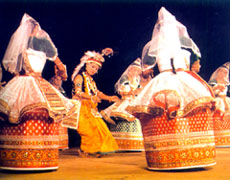|
|

|
|

| INTRODUCTION LITERARY WORKS MOVEMENTS TECHNIQUE MUSIC, COSTUMES & ENSEMBLES REPERTOIRE DANCERS |
Manipuri has a flow and a grace which contrasts from the precision of the
South Indian styles. This im pression of ease and fluidity results from an
unusual treatment of the body. The vertical line of the body is never broken
The body merely curves itself into a figure of 8. The positions attained are
thus relaxed and controlled rather than sculpturesque. An effort is made to
connect two parts of the body through beautiful curves. There are no sudden
transitions from particular horizontal sutras as in Bharatnatyam. The knees are
kept close together and the body is held upright but without any tension. The
torso is not treated as a unit, but is divided into two distinct parts above
the Katisutras, the chest and the waist. Neither unit is used singly
because the bend of any part by itself would mean creating an angle. Thus, the
chest and the waist, although moving in opposition, are always connected. The
effect is of the slow drawing of a curve in the shape of "S", but is
never a simple bend. The neck and the head follow this principle but the head
never moves horizontally. It also executes a figure 8 in space. The arms and
hands follow the pattern of the lower limbs and the torso. They too are never
tense nor are they even in acute flexion. They are held, in a naturally relaxed
manner away from the body in a semi-circular curve. The wrists plays an
extremely important part in the movement of the hands and the fingers, because
it is the wrists which give the movements of the fingers a unique fluidity. A
basic movement is the gradual closing in an opening out of the fingers; while
the wrist attempts to execute a lateral figure of 8. The face is placid and
without any exaggerated facial expressions. This controlled, but not unduly
severe or austere, expression is sustained throughout the performance.
pression of ease and fluidity results from an
unusual treatment of the body. The vertical line of the body is never broken
The body merely curves itself into a figure of 8. The positions attained are
thus relaxed and controlled rather than sculpturesque. An effort is made to
connect two parts of the body through beautiful curves. There are no sudden
transitions from particular horizontal sutras as in Bharatnatyam. The knees are
kept close together and the body is held upright but without any tension. The
torso is not treated as a unit, but is divided into two distinct parts above
the Katisutras, the chest and the waist. Neither unit is used singly
because the bend of any part by itself would mean creating an angle. Thus, the
chest and the waist, although moving in opposition, are always connected. The
effect is of the slow drawing of a curve in the shape of "S", but is
never a simple bend. The neck and the head follow this principle but the head
never moves horizontally. It also executes a figure 8 in space. The arms and
hands follow the pattern of the lower limbs and the torso. They too are never
tense nor are they even in acute flexion. They are held, in a naturally relaxed
manner away from the body in a semi-circular curve. The wrists plays an
extremely important part in the movement of the hands and the fingers, because
it is the wrists which give the movements of the fingers a unique fluidity. A
basic movement is the gradual closing in an opening out of the fingers; while
the wrist attempts to execute a lateral figure of 8. The face is placid and
without any exaggerated facial expressions. This controlled, but not unduly
severe or austere, expression is sustained throughout the performance.
In the Lasya portions the dancer does not and cannot lift her foot away from the ground above the level of the knee. The release from the ground is invariably characterized by a sweep of the ground, a gliding movement almost touching the floor rather than a movement where the foot is lifted high above the ground.
The situation changes considerably in the tandava portion known for its agility, verve and high leaps. The basic position in tandava is no longer the closed feet with knees bent in front leaving no space between them. There is nearly a four tala distance between the two feet and the knees are bent in front. In the tandava portions, the torso is occasionally treated as a separate unit and side bends are frequent. There are many sitting positions and many spirals and turns known to the dance styles, both in lasya and tandava. In lasya, the sthanakas or various positions once again attempt to limit space and although women dancers change the level throughout a performance, there is hardly ever much space between the two feet. In the tandava portions, the sthanakas take the form of positions known as the Vrischika Karnas of the Natyasastra tradition. There are few leg extensions in the lasya or tandava portions.
Hip movements are not allowed in the tandava and lasya portions. There is one type of thigh or pelvic movement known to the dance style. It is an up and down movement and it is achieved through knee dips and through a suggestion of a hop on the toe.
The manner of covering space in Manipuri, is expressive of its grace and delicacy. The dancer covers floor space also in figures of 8 and then the foot is lifted to cover space, it invariably touches the ground by a slight toe movement rather than flat foot or the heal. The Kunchita foot or the agratalasanchara foot of the Natyasastra is seen repeatedly in this dance style.